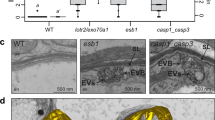Summary
Callus-derived suspension cultures of oats dramatically increase the viscosity of the culture media after one month in culture. Colorimetric assays for sugars and protein, as well as measurements of viscosity, suggest that the released material is a long-chain polysaccharide, probably a pectinaceous substance. These cells grow slowly in liquid culture, yet despite their low cell density, they are able to increase the viscosity of the media several fold within seven days after media transfer. Ultrastructural observations show that oat cells have features common to actively-secreting cells; especially evident are numerous dictyosomes with hypertrophied cisternae. Using a combination of filtering and centrifugation techniques we were able to recover large numbers of intact secretory vesicles. The interior of the vesicles stain with periodic acid-silver hexamine, and colormetric analysis of the vesicle pellet for total sugars confirms the presence of polysaccharides in this vesicle fraction. Because of the uniformity of these cells, the high rate of secretion, and the accessability of a large vesicle population, this culture system is'a useful model for studying the secretory process in plant cells.
Similar content being viewed by others
References
Bauer, W. D., Talmadge, K. W., Keegstra, K., Albersheim, P., 1973: The structure of plant cell walls. II. The hemicellulose of walls of suspension cultured sycamore cells. Plant Physiol.51, 174–187.
Becker, G. E., Hui, P. A., Albersheim, P., 1964: Synthesis of extracellular polysaccharides by suspensions ofAcer pseudo-platanus cells. Plant Physiol.39, 913–920.
Bitter, T., Muir, H. M., 1962: A modified uronic acid carbazole reaction. Anal. Biochem.4, 330–334.
Bradford, M. M., 1976: A rapid and sensitive method for the quantitation of microgram quantities of protein utilizing the principle of protein-dye binding. Anal. Biochem.72, 248–254.
Claude, A., 1970: Growth and differentiation of eytoplasmic membranes in the course of lipoprotein granule synthesis in the hepatic cell. I. Elaboration of elements of the Golgi complex. J. Cell Biol.47, 745–766.
Dinsdale, A., Moore, F., 1962: Viscosity and its measurement. New York: Institute of Physics and Physical Society.
Dubois, M., Gilles, K. A., Hamilton, J. K., Rebers, P. A., Smith, F., 1956: Colorimetric method for determination of sugars and related substances. Anal. Chem.28, 350–356.
Gamborg, O. L., Miller, R. A., Ojima, K., 1968: Nutrient requirements of suspension cultures of soybean root cells. Exptl. Cell Res.50, 151–158.
Holwill, M. E., Silvester, N. R., 1973: Introduction to biological physics. New York: John Wiley.
Loud, A. V., 1962: A method for the quantitative estimation of eytoplasmic structures. J. Cell Biol.15, 481–487.
Mollenhauer, H. H., Morré, D. J., 1966: Golgi apparatus and plant secretion. Ann. Rev. Plant Physiol.17, 27–46.
— —,Vanderwoude, W. J., 1975: Endoplasmic reticulum-Golgi apparatus associations in maize root tips. Mikroskopie31, 257–272.
—,Whaley, W. G., Leech, J. H., 1961: A function of the Golgi apparatus in outer root cap cells. J. Ultrastruct. Res.5, 193–200.
Northcote, D. H., Pickett-Heaps, J. D., 1966: A function of the Golgi apparatus in polysaccharide synthesis and transport in the root cap cells of wheat. Biochem. J.98, 159–167.
Palade, G., 1975: Intracellular aspects of the process of protein synthesis. Science189, 347–358.
Pickett-Heaps, J. D., 1968: Further ultrastructural observations on polysaccharide localization in plant cells. J. Cell Sci.3, 55–64.
Ray, P. M., Eisinger, W. R., Robinson, D. G., 1976: Organelles involved in cell wall polysaccharide formation and transport in pea cells. Ber. dtsch. bot. Ges.89, 121–146.
Robinson, D. G., Eisinger, W. R., Ray, P. M., 1976: Dynamics of the Golgi system in wall matrix polysaccharide synthesis and secretion by pea cells. Ber. dtsch. bot. Ges.89, 147–161.
Spurr, A. R., 1969: A low-viscosity epoxy resin embedding medium for electron microscopy. J. Ultrastruct. Res.26, 31–43.
Updegraff, D. M., 1969: Semimicro determination of cellulose in biological materials. Anal. Biochem.32, 420–424.
Vanderwoude, W. J., Morré, D. J., Bracker, C. E., 1971: Isolation and characterization of secretory vesicles in germinated pollen ofLilium longiflorum. J. Cell Sci.8, 331–351.
Author information
Authors and Affiliations
Additional information
Scientific Article No. A-3128, Contribution No. 6196 of the Maryland Agricultural Experiment Station, College Park, MD.
Rights and permissions
About this article
Cite this article
Conrad, P.A., Binari, L.L.W. & Racusen, R.H. Rapidly-secreting, cultured oat cells serve as a model system for the study of cellular exocytosis. Characterization of cells and isolated secretory vesicles. Protoplasma 112, 196–204 (1982). https://doi.org/10.1007/BF01284094
Received:
Accepted:
Issue Date:
DOI: https://doi.org/10.1007/BF01284094




